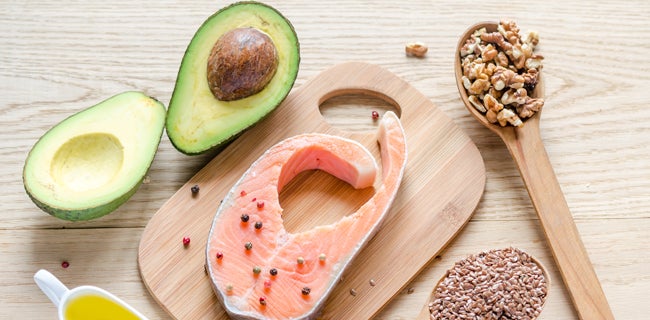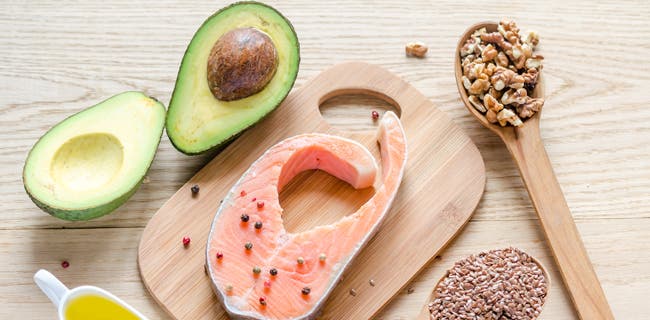Face The Fats


Heart disease, cancer, diabetes, obesity. Is there any illness that hasn’t been blamed on eating too much fat? No macronutrient has been as maligned. For decades, it was almost de rigueur for health professionals to extol the virtues of fat-free eating to their clients. Almonds were left to molder on store shelves, and anything other than skim milk was deemed a health pariah.
Thankfully, that dark period is over. The new standard, supported by more rigorous research, is that we all need some fat in our diets to fend off chronic disease and, seemingly paradoxically, stay trim. In a 2012 Journal of the American Medical Association study, researchers compared participants on three diets: low-fat, low-glycemic and low-carb. The results showed that following a low-fat diet (20 percent of overall calories from fat) decreased resting energy expenditure (i.e., the number of calories you burn while at rest) the most. That means that the bodies that got the least fat burned the fewest calories while at rest.
The challenge now is sourcing the right kinds of fats in the correct amounts. Read on to find out why we’d say “fat chance” to achieving peak health and fitness without these six fabulous fats.
EPA and DHA
Talk about your overachieving fats. A raft of research papers have shown that people who take in higher amounts of the omega-3 fatty acids eicosapentaenoic acid and docosahexaenoic acid have improved heart, joint, brain, immune and eye health. Many of the benefits associated with increased intakes of these phat fats can be chalked up to their strong anti-inflammatory powers. And there are plenty of other reasons those in the pursuit of a glance-stealing physique will want to load up on them. Studies show that DHA and EPA can improve muscular strength, increase muscle protein synthesis and encourage fat burning.
Get what you need: A British Journal of Nutrition study determined that 250 milligrams a day is the minimum amount of these omega-3 fats needed to confer cardioprotective benefits, but for optimal health and fitness gains, the ideal dose could be up to an average of 1,000 milligrams daily. You can reel in more DHA and EPA by regularly consuming fatty fish such as salmon, trout, mackerel, sardines and sablefish. As good insurance, also consider using a daily supplement that provides about 1,000 milligrams of DHA and EPA combined.
Conjugated Linoleic Acid
In recent years, conjugated linoleic acid has gained many fans among the fitness-minded. That’s because this polyunsaturated fat might help bring your six-pack to the forefront. CLA appears to take part in a multi-pronged attack on body fat by improving insulin sensitivity, influencing gene regulation and revving up lipoprotein lipase — an enzyme that promotes fat metabolism. Further, a study in the Journal of Medicinal Foods found that CLA can improve exercise endurance by increasing the burning of fat to generate energy during activity. Research papers also suggest that consuming more CLA can protect against certain cancers and weakening bones by helping quell internal inflammation.
Get what you need: The main dietary sources of CLA are meat and dairy. Unfortunately, CLA levels in food products have declined significantly over the years as a result of changes in how animals are raised and fed, as well as the proliferation of fat-free dairy products in households. Meats and dairy sourced from pasture-fed animals have been found to contain significantly more CLA than what is sourced from grain-fed animals. To obtain a fat-burning benefit, you’ll probably want to focus on getting CLA through supplementation. Try taking 1 to 3 grams of CLA twice daily with meals. And stick with it — it will likely take several weeks before you see results.
Monounsaturated Fat
Want to show your ticker some love? Infuse your diet with monounsaturated fat. It’s one of the major lynchpins in the vaunted Mediterranean diet, and studies have found that consuming adequate amounts of these fats can slash heart disease risk by lowering blood pressure as well as increasing levels of good cholesterol and decreasing amounts of harmful triglycerides circulating through your blood. Studies also suggest that a monounsaturated-fat-rich diet can reduce the glycemic load of the diet, which can reduce the risk for diabetes and fat gain by improving blood sugar numbers. Further, a 2013 study in The American Journal of Clinical Nutrition reported that replacing some of the palmitic acid, the main saturated fat found in dairy, beef and other animal-based foods, with monounsaturated fats like oleic acid can increase resting energy expenditure, which may help you ditch some of that extra padding on your midriff.
Get what you need: Ideally, you want 15 to 20 percent of your daily calories to come from monounsaturated fats. The best dietary sources include nuts, seeds, avocados and various culinary oils like olive, avocado and almond. If those sound like the perfect salad toppers, so much the better. A recent study by the white coats at Purdue University in Indiana found that adding a shot of monounsaturated fat to veggie-based salads greatly increased the absorption of disease-thwarting fat-soluble antioxidants like beta-carotene and lycopene.
Alpha-Linolenic Acid
While not as potent as EPA and DHA, this type of omega-3 fat is not to be overlooked. Mainly because alpha-linolenic acid can help protect us against the biggest killer in America: heart disease. It’s thought that ALA fends off coronary woes by helping to reduce inflammation in the body. Further, scientists at the University of Washington in Seattle discovered that individuals with the highest blood levels of ALA were at lower risk for developing diabetes. It’s also believed that adequate intakes of omega-3s are needed for better skin health. And those who don’t consume seafood can get a boost from ALA — the human body can convert some of it into EPA and DHA.
Get what you need: ALA is found in plant foods like flaxseed, hempseed, chia seed, walnuts and canola oil.
Medium-Chain Triglycerides
Struggling to whittle the middle? Consider searching out medium-chain triglycerides. The specialty of this saturated fat is that it’s metabolized differently than other fats, which can lead to a reduction of fat storage in the body. Case in point: An American Journal of Clinical Nutrition study that administered 4 to 5 teaspoons of MCT oil or olive oil daily to subjects for four months determined that those consuming the former lost more bodyweight and fat mass than those exposed to the olive variety. Because of a unique molecular structure, namely having a shorter length of carbon atoms than other fats, MCTs like lauric acid are rapidly metabolized by the body once consumed and are therefore less likely to be added to fat stores.
Get what you need: Coconut oil and red palm oil are the primary dietary sources for MCTs. You can use both for cooking and baking needs in the place of other oils or butter. Also, consider taking 1 to 2 tablespoons of supplemental MCT oil with your meals.
Saturated Fat
Though it continues to be castigated as a health hazard, the reality is that we all need some saturated fat in our diets for good health. For example, it’s a major player in the production of sex hormones, meaning it’s required to keep testosterone levels up. Testosterone is the most important anabolic hormone in the body, making it vital for building muscles and boosting muscular strength. What’s more, in recent years a spat of research has called into question the link between saturated-fat intake and heart disease and instead suggested that high intakes of processed carbohydrates and trans fats are larger contributors to an ailing ticker. For example, an investigation in The American Journal of Clinical Nutrition determined that individuals who replaced saturated fats in their diets with high-glycemic carbs like white bread and sugary drinks experienced a higher risk of suffering a heart attack during a 12-year study period.
Get what you need: You can source an appropriate amount of saturated fat from meats, milk, yogurt, cheese and tropical oils like coconut.
About 8 to 10 percent of total calories can come from saturated fat without any health concerns. Just don’t go serving yourself Flintstone-size porterhouse steaks and whirling whole milk into all your protein shakes.
Fat the Bad
Not all fats are nutritional saints. Continue to be wary of these two.
Omega-6 Fats
In many ways, omega-6 fatty acids like linoleic acid are the Dr. Jekyll and Mr. Hyde of the fat world. While omega-6s are considered essential because we must obtain them from the diet for our bodies to function properly, the concern these days is that we are consuming way too much of them. When present in the diet in excessive amounts, omega-6s crowd out omega-3s and have a pro-inflammatory impact, which sets the stage for a range of maladies, including heart disease and diabetes. Why the omega-6 onslaught? For starters, a glut of cheap omega-6-rich vegetable oils, like soybean oil, have worked their way into the Standard American Diet via restaurants and packaged foods. Also, cattle and fish like tilapia that are fattened up on grains have much higher amounts of omega-6 fats than their pasture-fed and wild counterparts.
While today’s average diet has an omega-6-to-omega-3 ratio of about 15:1, most health experts agree that for good health this should be much closer to even. You can get there by eating more omega-3-rich foods like seeds and fatty fish at the expense of processed foods.
Trans Fats
While the amount of trans fat found in supermarket packaged foods and restaurant fare has been steadily dropping in recent years, it can still be found in certain margarines, cookies and baked goods. There is really no amount of this killer fat that is safe to eat, so make sure to scan ingredient lists and online restaurant menus for the word “hydrogenated,” which is a sure sign that trans fats are present.